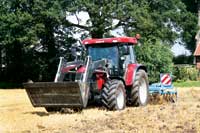Tractor Test: Case IH CS105 Pro

The CS is a real classic. Steyr started out with it in 1995 and the current CS105 Pro has been uprated in many areas while retaining its key strengths. However the Sisu engine didn’t prove too thrifty.
Engine 6/10
The 4.4-litre engine comes from Finnish firm Sisu (Valtra’s sister company). At rated rpm the tractor delivered 83hp at the pto with a specific consumption only a little over the group average. There’s not much power left after this, though.
So 84hp was the peak, leaving the tractor 9hp behind its group mates. And even at that power level the engine used 286g/kWh – the highest specific consumption in the peak power test.
The pictured changed a little when it came to our 6-point average: consumption was 303 g/kWh and thus only 7g – or around 2% – over the group average of 296g.
The constant power range tended to be modest with the Sisu engine achieving only 20%. At rated rpm, draft was average at 70hp and once again peak performance here brought only an extra 1hp. Specific consumption at rated rpm was just under the test average. At peak power the Case chalked up the second highest consumption, at 336g/kWh.
Transmission 5/10
The ZF transmission has two ranges, four main gears and a twin splitter. But the splitter cannot be used in reverse so we ended up with just 16F x 8R gears.
In the working range of 4 to 12kph eight ratios are available. However there was a big gap between third and fourth gears in low range and first and second in high range. Case IH need to give this tractor a three-range powershift and one which can also be used in reverse.
The range box is unsynchronised and can only be changed when the tractor is stationary. However, between-the-gears changes are smooth.
Shuttle action is excellent and can be activated by the column-mounted lever or by a button on the multicontroller joystick.
If the button on the end of the shuttle lever is pushed the transmission slips into neutral. The tractor pulls away smoothly with either the gearstick clutch button or the pedal – even under load.
Cab 8/10
Saddling up is easy enough, even from the right. The cab interior feels comparatively dark and low but forward and rear visibility makes up for this. Thin pillars and doors positioned well to the rear aid views to the sides. Link arm hooks are clearly on view – even though the rear window is shallow.
We didn’t feel completely at home with the plastic skylight. While it is possible to open it in all directions, it is still very small and murky and collects dust fast and scratches even faster. There is no substitute for glass in this respect.
Air conditioning is positioned in the roof-lining and the heater in the steering column, giving a cool head and warm feet. A low-line cab is also offered (11cm lower), although without air conditioning. There are four worklights facing forwards and the same number to the rear with a xenon option.
Case IH delivers a nicely ergonomic workspace, although not a really quiet one. The DLG testers recorded 81dB(A) under load, somewhat above the test average of 77 dB(A).
The optional multicontroller joystick scored highly with all the testers. It not only handles the gears and shuttle, but also offers buttons for spool valve control, splitter, the clutch and linkage.
Hydraulics 9/10
There are two sets of switches for the electronic linkage control, one on the side console and another on the multicontroller. In reality it’s the latter that always gets used.
The adjustment dials for drop-rate, lift height and draft intermix line up on the side console. When operated via the external controls the link-arms move slowly at first and then speed up – nice and practical.
Linkage damping is activated automatically over 8kph. At 4.3t, lift capacity is around the group average while lift range is well above average.
The CS has separate oil reserves for transmission and hydraulics with 29 litres of oil available for ancillary equipment. With just under 90 litres/min capacity, pump ouput is substantially better than the average – a real plus-point for loader work.
Pto 8/10
The CS series comes with a four speed pto: 540, 1000, 540E and 430 (a speciality for heavy work with implements like mowers and forage wagons). The ratios are easily selected with two levers. The pto rocker switch lies to hand alongside a switch for the excellent automatic function. The aggressivity of pto start-up and the linkage position that kicks it in and out of gear are programmable – but that requires quite a bit of know-how. If the switch for the auto pto is pressed too long, you’re suddenly back in programming mode. Outside controls are on both rear wings.
4WD/diff-lock 10/10
In auto function 4wd kicks out above 14kph and back in again when speeds drop. For mowing or stubble work 14kph is too low a limit.
The diff-lock is top class, releasing at over 14kph, when the arms raise or when the brakes are applied.
Driving comfort 7/10
With the second-longest wheelbase in the test, the CS scores well for road-going comfort and there’s very little negative effect on turning circle.
The steering is pleasurably precise and direct (3.5 turns from lock-to-lock). An audio warning reminds the driver to pull on the handbrake when he leaves the seat.
Unfortunately this doesn’t sound when driving off without releasing the handbrake…
For more from our tractor test click here

